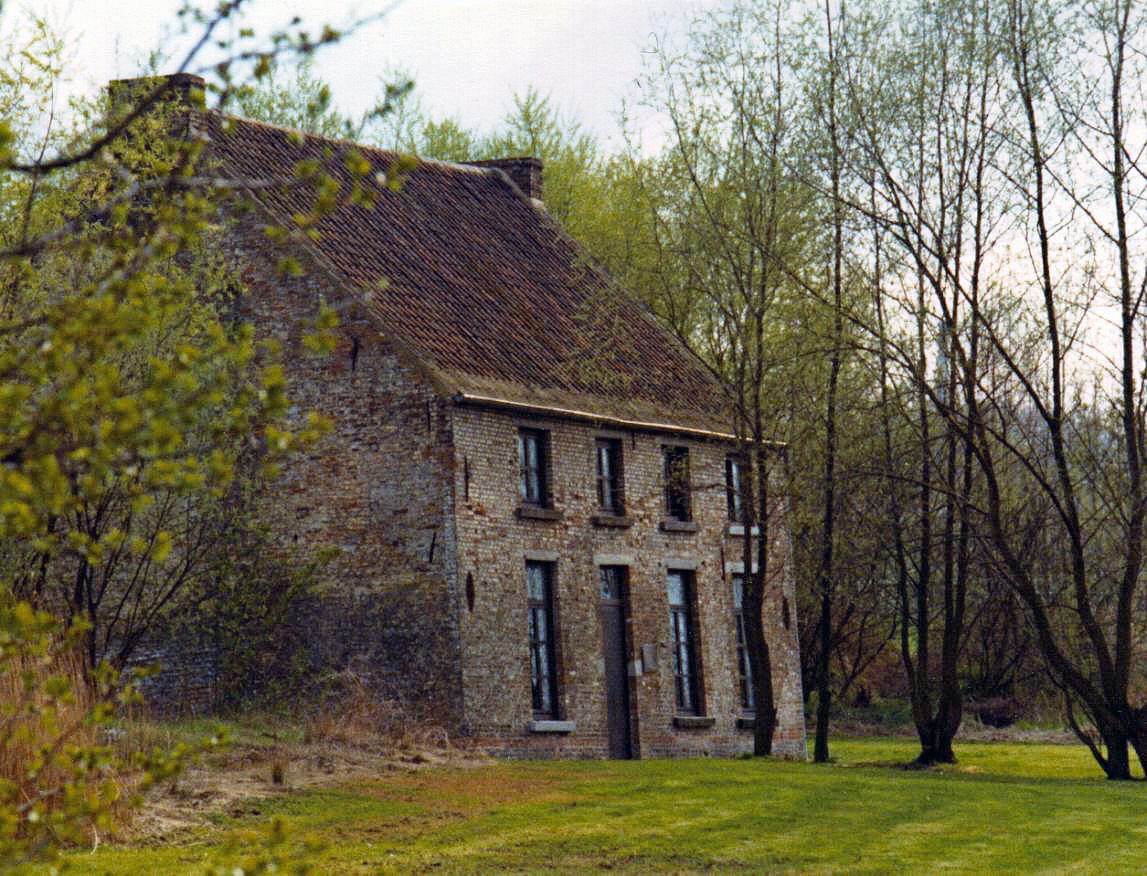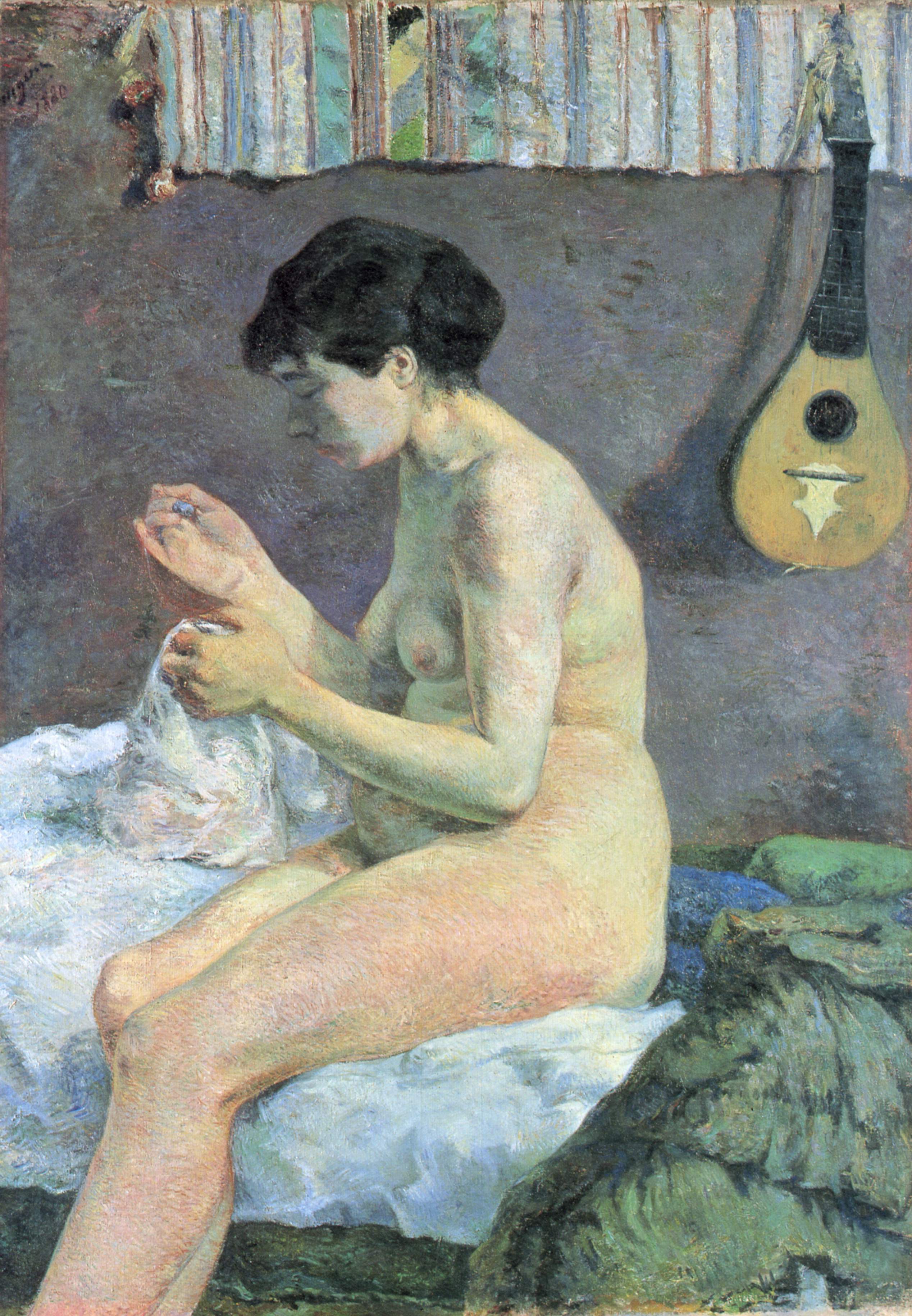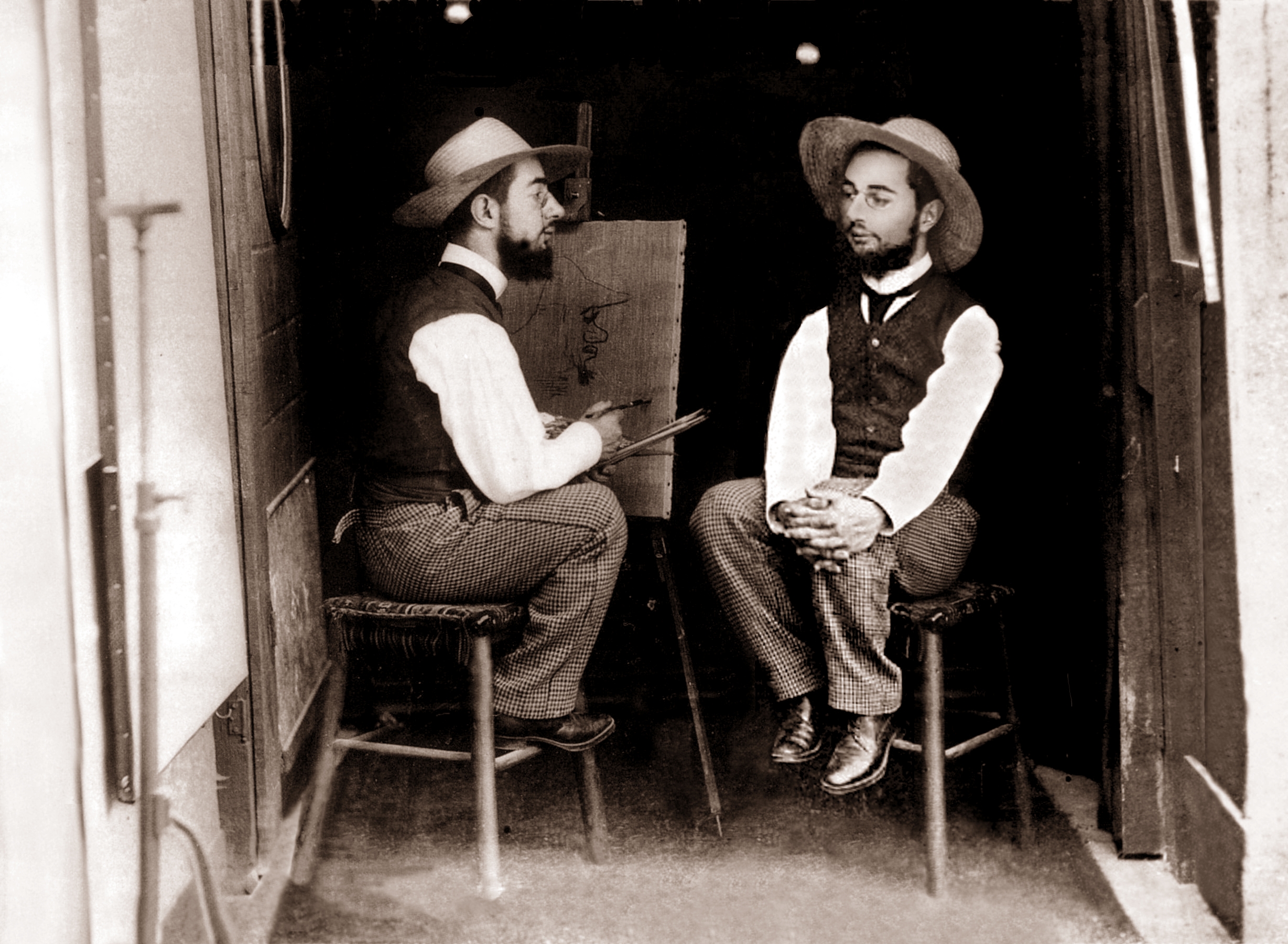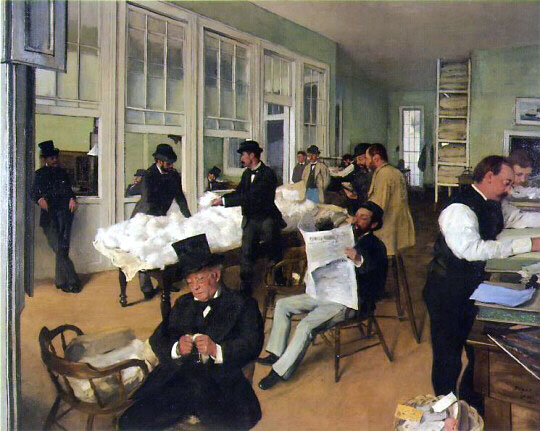|
Agostina Segatori Sitting In The Café Du Tambourin
''Agostina Segatori Sitting in the Café du Tambourin'' was painted by Vincent van Gogh in 1887. Agostina Segatori owned the Café du Tambourin that Van Gogh knew intimately. It was a gathering spot for Parisian artists, a place where their work was exhibited. Van Gogh, unable to pay in cash for his meals, exchanged paintings for his fare. The paintings then adorned the restaurant. He held a special exhibit of Japonaiserie (Van Gogh), his Japanese prints in the café as well. His connection with Agostina and the cafe came to a sad end when she went bankrupt and van Gogh's paintings were confiscated by creditors. This painting, however, demonstrates an artistic discovery that culminated in his unique, creative style not quite on the brink of being understood and revered. Van Gogh's influence in Paris In 1886 van Gogh left the Netherlands, never to return, for Paris and the guidance of his brother Theo van Gogh (art dealer), Theo. He entered Paris as a shy, somber man and whi ... [...More Info...] [...Related Items...] OR: [Wikipedia] [Google] [Baidu] |
Vincent Van Gogh
Vincent Willem van Gogh (; 30 March 185329 July 1890) was a Dutch Post-Impressionist painter who is among the most famous and influential figures in the history of Western art. In just over a decade, he created approximately 2,100 artworks, including around 860 oil paintings, most of them in the last two years of his life. His oeuvre includes Trees and Undergrowth (Van Gogh series), landscapes, Still life paintings by Vincent van Gogh (Paris), still lifes, Portraits by Vincent van Gogh, portraits, and Portraits of Vincent van Gogh, self-portraits, most of which are characterised by bold colours and dramatic Paintwork, brushwork that contributed to the rise of expressionism in modern art. Van Gogh's work was only beginning to gain critical attention before he died from a self-inflicted gunshot at age 37. During his lifetime, only one of Van Gogh's paintings, ''The Red Vineyard'', was sold. Born into an upper-middle-class family, Van Gogh drew as a child and was serious, qui ... [...More Info...] [...Related Items...] OR: [Wikipedia] [Google] [Baidu] |
Paul Gauguin
Eugène Henri Paul Gauguin (; ; 7 June 1848 – 8 May 1903) was a French painter, sculptor, printmaker, ceramist, and writer, whose work has been primarily associated with the Post-Impressionist and Symbolist movements. He was also an influential practitioner of wood engraving and woodcuts as art forms. While only moderately successful during his life, Gauguin has since been recognized for his experimental use of color and Synthetist style that were distinct from Impressionism. Gauguin was born in Paris in 1848, amidst the tumult of Europe's revolutionary year. In 1850, Gauguin's family settled in Peru, where he experienced a privileged childhood that left a lasting impression on him. Later, financial struggles led them back to France, where Gauguin received formal education. Initially working as a stockbroker, Gauguin started painting in his spare time, his interest in art kindled by visits to galleries and exhibitions. The financial crisis of 1882 significantly impact ... [...More Info...] [...Related Items...] OR: [Wikipedia] [Google] [Baidu] |
French Franc
The franc (; , ; currency sign, sign: F or Fr), also commonly distinguished as the (FF), was a currency of France. Between 1360 and 1641, it was the name of coins worth 1 livre tournois and it remained in common parlance as a term for this amount of money. It was reintroduced (in French livre, decimal form) in 1795. After two centuries of inflation, it was Redenomination, redenominated in 1960, with each (NF) being worth 100 old francs. The NF designation was continued for a few years before the currency returned to being simply the franc. Many French residents, though, continued to quote prices of especially expensive items in terms of the old franc (equivalent to the new centime), up to and even after the introduction of the euro (for coins and banknotes) in 2002. The French franc was a commonly held international reserve currency of reference in the 19th and 20th centuries. Between 1998 and 2002, the conversion of francs to euros was carried out at a rate of 6.55957 franc ... [...More Info...] [...Related Items...] OR: [Wikipedia] [Google] [Baidu] |
Centimes
Centime (from ) is French for " cent", and is used in English as the name of the fraction currency in several Francophone countries (including Switzerland, Algeria, Belgium, Morocco and France). In France, the usage of ''centime'' goes back to the introduction of the decimal monetary system under Napoleon. This system aimed at replacing non-decimal fractions of older coins. A five-centime coin was known as a ''sou'', i.e. a solidus or shilling. In Francophone Canada of a Canadian dollar is officially known as a ''cent'' (pronounced /sɛnt/) in both English and French. However, in practice, the form of ''cenne'' (pronounced /sɛn/) has completely replaced the official ''cent''. Spoken and written use of the official form ''cent'' in Francophone Canada is exceptionally uncommon. In the Canadian French vernacular ''sou'', ''sou noir'' ( means "black" in French), ''cenne'', and ''cenne noire'' are all widely known, used, and accepted monikers when referring to either of a Can ... [...More Info...] [...Related Items...] OR: [Wikipedia] [Google] [Baidu] |
Paul-Albert Besnard
Paul-Albert Besnard (2 June 1849 – 4 December 1934) was a French painter and printmaker. Biography Besnard was born in Paris and studied at the École des Beaux-Arts, studied with Jean Bremond and was influenced by Alexandre Cabanel. He won the Prix de Rome in 1874 with the painting ''Death of Timophanes''. On 19 November 1879 he married the sculptor Charlotte Dubray (1854–1931). They had four children, of whom three were artists. Until about 1880 he followed the academic tradition, but then broke away completely, and devoted himself to the study of colour and light as conceived by the Impressionists. The realism of this group never appealed to his bold imagination, but he applied their technical method to ideological and decorative works on a large scale, such as his frescoes at the Sorbonne, the Ecole de Pharmacie, the ceiling of the Comédie-Française (main theatre in Paris), the Salle des Sciences at the Hôtel de Ville, the ''mairie'' of the 1st arrondissement, ... [...More Info...] [...Related Items...] OR: [Wikipedia] [Google] [Baidu] |
Henri De Toulouse-Lautrec
Count, ''Comte'' Henri Marie Raymond de Toulouse-Lautrec-Monfa (24 November 1864 – 9 September 1901), known as Toulouse-Lautrec (), was a French painter, printmaker, draughtsman, caricaturist, and illustrator whose immersion in the colourful and theatrical life of Paris in the late 19th century allowed him to produce a collection of enticing, elegant, and provocative images of the sometimes decadent affairs of those times. Born into the aristocracy, Toulouse-Lautrec broke both his legs during adolescence, leaving him with a stunted appearance. In later life, he developed an affinity for brothels and prostitutes that directed the subject matter for many of his works, which record details of the late-19th-century bohemian lifestyle in Paris. He is among the painters described as being Post-Impressionism, Post-Impressionists, with Paul Cézanne, Vincent van Gogh, Paul Gauguin, and Georges Seurat also commonly considered as belonging in this loose group. In a 2005 auction at ... [...More Info...] [...Related Items...] OR: [Wikipedia] [Google] [Baidu] |
Boulevard De Clichy
The Boulevard de Clichy () is a famous street of Paris, which lends its name to the Place de Clichy, resulted from the fusion, in 1864, of the roads that paralleled the Wall of the Farmers-General, both inside and out. It extends from the Place de Clichy to the Rue des Martyrs, nearly a kilometre away. During its tenure, the street has been known as the ''Boulevard des Martyrs'', then the ''Boulevard Pigalle'', and, finally, the ''Boulevard de Clichy''. It is equally well known as the Boulevard Clichy. Notable buildings *No. 6: The painter, Edgar Degas, lived here; he also died on the fifth floor of this house, in 1917, aged 83. *No. 11: This house was occupied by Théophile Delcassé, for many years the French Foreign Minister, and it was also the rented quarters of many artists, among them Pablo Picasso in 1909. *No. 12: This was studio of French painter William Didier-Pouget, and the ''pied-à-terre'', in 1910, of the painter Francis Tattegrain. *No. 18: Boulevard Pigalle ... [...More Info...] [...Related Items...] OR: [Wikipedia] [Google] [Baidu] |
Jean-Baptiste-Camille Corot
Jean-Baptiste-Camille Corot ( , , ; 16 July 1796 – 22 February 1875), or simply Camille Corot, was a French Landscape art, landscape and Portraitist, portrait painter as well as a printmaking, printmaker in etching. A pivotal figure in landscape painting, his vast output simultaneously referenced the Neoclassicism, Neo-Classical tradition and anticipated the en plein air, plein-air innovations of Impressionism. Biography Early life and training Jean-Baptiste-Camille Corot was born in Paris on 16 July 1796 in a house at 125 Rue du Bac, Paris, Rue du Bac, now demolished. His family were bourgeois people—his father was a wig maker and his mother, Marie-Françoise Corot, a milliner—and unlike the experience of some of his artistic colleagues, throughout his life he never felt the want of money, as his parents made good investments and ran their businesses well. After his parents married, they bought the millinery shop where his mother had worked and his father gave up ... [...More Info...] [...Related Items...] OR: [Wikipedia] [Google] [Baidu] |
Portrait Of Père Tanguy
''Portrait of Père Tanguy'', painted by Vincent van Gogh in 1887, is one of his three paintings of Julien Tanguy. The three works demonstrate a progression in van Gogh's artistic style after his arrival in Paris. The first is somber, and formed from a simple composition. The second introduces van Gogh's Japanese prints. The last and most advanced in style, skill and color integrates Japanese, Impressionist, and other influences on the Parisian artist community. This painting conveys a sense of serenity that van Gogh seeks for himself. This last painting of Tanguy is in the Musée Rodin, Paris. Van Gogh in Paris In 1886 van Gogh left the Netherlands never to return. He moved to Paris to live with his brother Theo, a Parisian art dealer. Vincent entered Paris as a shy, somber man. While his personality would never change, he emerged artistically into what one critic described as a "singing bird". Although van Gogh had been influenced by great masters in the Netherlands, coming t ... [...More Info...] [...Related Items...] OR: [Wikipedia] [Google] [Baidu] |
Van Gogh - Portrait Of Pere Tanguy 1887-8
A van is a type of road vehicle used for transporting goods or people. There is some variation in the scope of the word across the different English-speaking countries. The smallest vans, microvans, are used for transporting either goods or people in tiny quantities. Mini MPVs, compact MPVs, and MPVs are all small vans usually used for transporting people in small quantities. Larger vans with passenger seats are used for institutional purposes, such as transporting students. Larger vans with only front seats are often used for business purposes, to carry goods and equipment. Specially equipped vans are used by television stations as mobile studios. Postal services and courier companies use large step vans to deliver packages. Word origin and usage Van meaning a type of vehicle arose as a contraction of the word caravan. The earliest records of a van as a vehicle in English are in the mid-19th century, meaning a covered wagon for transporting goods; the earliest reported rec ... [...More Info...] [...Related Items...] OR: [Wikipedia] [Google] [Baidu] |
Édouard Manet
Édouard Manet (, ; ; 23 January 1832 – 30 April 1883) was a French Modernism, modernist painter. He was one of the first 19th-century artists to paint modern life, as well as a pivotal figure in the transition from Realism (art movement), Realism to Impressionism. Born into an upper-class household with strong political connections, Manet rejected the naval career originally envisioned for him; he became engrossed in the world of painting. His early masterworks, Le Déjeuner sur l'herbe, ''The Luncheon on the Grass'' (''Le déjeuner sur l'herbe'') and ''Olympia (Manet), Olympia'', premiering in 1863 and '65, respectively, caused great controversy with both critics and the Academy of Fine Arts, but soon were praised by progressive artists as the breakthrough acts to the new style, Impressionism. These works, along with others, are considered watershed paintings that mark the start of modern art. The last 20 years of Manet's life saw him form bonds with other great artists of ... [...More Info...] [...Related Items...] OR: [Wikipedia] [Google] [Baidu] |
Edgar Degas
Edgar Degas (, ; born Hilaire-Germain-Edgar De Gas, ; 19 July 183427 September 1917) was a French Impressionist artist famous for his pastel drawings and oil paintings. Degas also produced bronze sculptures, prints, and drawings. Degas is especially identified with the subject of dance; more than half of his works depict dancers. Although Degas is regarded as one of the founders of Impressionism, he rejected the term, preferring to be called a realist,Gordon and Forge 1988, p. 31 and did not paint outdoors as many Impressionists did. Degas was a superb draftsman, and particularly masterly in depicting movement, as can be seen in his rendition of dancers and bathing female nudes. In addition to ballet dancers and bathing women, Degas painted racehorses and racing jockeys, as well as portraits. His portraits are notable for their psychological complexity and their portrayal of human isolation. At the beginning of his career, Degas wanted to be a history painter, a callin ... [...More Info...] [...Related Items...] OR: [Wikipedia] [Google] [Baidu] |








